American Sabbatical 93: 4/14/97
Shiloh
4/14.. Shiloh.
A clear Southerly had blown the lowery sky away, but Monday was still a good day
for the layered look. We needed to cross the Tennessee, if we
were going to get back to 1862, so we saddled up in Savannah,
and put our faces to the wind.
One of Peggy’s topical targets has been the TVA, but we’ve managed
to dodge the waterworks at every turn. This morning, though, our
road crosses the Pickwick Dam, so we can investigate at least
one artifact of the Dam Builder Culture. In CADILLAC DESERT, that
exhaustive account of American dam building, the author suggests
that when our greatest impoundments have silted to the brim they
will make spectacular waterfalls. Will they last as long as the
Mississippian mounds?
This dam isn’t on the tourist trail, so they were unprepared for
the descent of the Owl. Peggy marched into the control room, however,
and charmed the supervisor into leaving his post, give her a short
tour, and dig some TVA literature out of a bottom drawer. The
Authority is suffering through hard times. Their enabling legislation
won’t permit TVA power to be sold to Arkansas or Birmingham, where
there are good markets, but out of state utilities can sell power
in Tennessee, and TVA is losing market share. And they’re having
infrastructure problems. He said they were real busy trying to
retrofit one of the dams “built in a hurry during the Second World
War.” Something about holding it together with cables. I whistled
softly as we tiptoed across the river.
(Memo #87)
April 14 Pickwick TVA Dam
WHO? Franklin Roosevelt, architect of the New Deal
WHAT? TVA (Tennessee Valley Authority) built series of 9 dams
on the Tennessee River
WHEN? Pickwick Dam built 1934-8, still working
HOW? Federal government funded as part of New Deal
TOPICS: New Deal, REA, TVA,
QUESTIONS: What was the purpose of the TVA? What were its costs
and benefits? In the long run was it “successful”? |
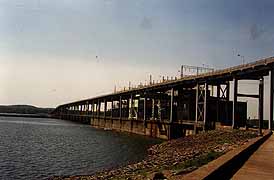
Pickwick Dam
|
When we visited the Grand Coulee dam in Washington state, we saw
part of the New Deal water projects. The Pickwick Dam in Tennessee
is another. I wrote about the Grand Coulee:
“The Columbia Basin Project and its many dams were launched by
the 1930’s New Deal. As part of PWA (Public Works Administration),
Franklin Roosevelt’s New Deal sponsored a number of major dam
projects, perhaps the most famous is the TVA (Tennessee Valley
Authority) a series of dams on the Tennessee River. As with most
New Deal projects, the dams had multiple purposes. The monumental
public works were intended to solve the problem of unemployment
in the Depression. The dams would assist farmers, perhaps the
poorest group in America, in several ways: providing water for
irrigation, controlling flood waters, providing electricity to
assist in agriculture (for example, refrigerating milk on dairy
farms), and electrifying farms so that farm families could use
a variety of household appliances. This would spur consumer industries.
Helping larger regions, the dams would create cheap electricity
for cities, and offer cheap electricity and labor to lure industries
into poor agricultural regions again providing long term employment.
(People always wonder about the funding - FDR also started the
modern national deficit).” The dams have created huge lakes and
spurred development of recreational facilities. Another benefit
of the dams has been easing navigational problems.

There are nine dams in the TVA system that provide electricity
for 7 million people in Tennessee, Alabama, Georgia, Kentucky,
Mississippi, North Carolina, and Virginia, from coal-fired, nuclear,
hydroelectric, and combustion turbines. Pickwick Dam is located
almost on the Tennessee-Mississippi border, just upriver from
Shiloh battlefield. While the Pickwick site does not have the
grandeur of the arid plains and stark cliffs surrounding Grand
Coulee, the dam still is amazing. You drive suddenly out of the
forests of southern Tennessee and see the lake, the powerhouse,
the dam.
Its statistics are New Deal scale: 7,715 feet long, 113 feet high,
3 million cubic yards of dirt and rock as well as 630 thousand
cubic yards of cement used. 2,400 workers built the dam while
1600 more cleared the lake area. It has two locks and produces
228,000 kw. Equipped with the largest turbine of its kind in 1934,
it cost $46 million. Pickwick’s lake is 53 miles long and has
a 500 mile shoreline. (We saw scores of boaters, fishermen, campers.)
The TVA and its nine dams control water from 0 to 81 feet above
sea level.
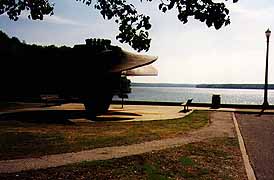
Turbine
|
Pickwick had no tours running and there was no one in the visitors
center. I’ve learned to explore in this kind of situation. I looked
around, took a TVA newspaper from a pile by the desk, signed the
guest register, and opened the door marked “visitors” to find
myself on a catwalk overlooking the generators. Seven engineers
were dismantling one. The noise was huge. The control room was
behind me and I gestured a question to the man in charge who came
out, answered questions, gave me more literature, and took me
on a modified tour. |
One point he explained was that the original TVA legislation created
“The Fence” outlining territory in which it can sell electricity.
The TVA cannot gain customers outside the fence, BUT other companies
can compete within the area. Apparently the TVA almost lost Memphis
recently! This, of course, gets in to the whole question of whether
the US government should be a public utilities company (or a health
insurance provider or a pension provider or...)
Two last points: (1) Pickwick is the name of a community (drowned
by the dam’s lake) whose postmaster loved Dickens. (2) There is
a TVA Live Well Center at Pickwick that is proposing a “Smart
Choice Challenge”: work out three times a week for eight weeks
and win a gym bag!
4/14.. Bryce's Shiloh.
The Shiloh battlefield is just downriver (north) of the 1930s, through more of the rolling
woodlands we’ve been seduced by in Tennessee. We’ve been drawn
to this Civil War site rather than others along the way, and are
not quite sure why. It certainly was a signal engagement, historically.
It identified Grant and Sherman as generals up to the task, and
convinced them, finally, that only a bloody fight to the end would
break the Confederacy. It gave the raw Army of Tennessee, as the
Union forces in the West were collectively known, the tempering
to make them the hammer that could go on to break Vicksburg and
Chattanooga. But it was a horribly bloody business, fought for
two days through Spring woods, with neither side able to choose
their ground. Just two masses of young men blundering against
each other among the dogwood and peach blossoms. When the cost
was counted both sides had to put aside all their romantic illusions.
| Now, I’ve never been enthusiastic about military monuments. Old
canons pointing across groomed fields. Piles of cannonballs. Granite
plinths and maudlin sculpture. So, while Peggy did the film and
display thing, I walked into the Shiloh Military Cemetery with
mixed emotions. Like, why am I parading around this old graveyard? |
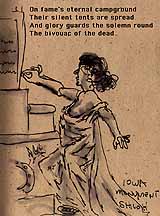
Iowa Monument - Shiloh
|
Still cool, but with a bright sun trying to soak into my blue
sweat-jacket. Intense green sod under the grand oaks. A pyramid
of zenith-pointing canons marking where Grant’s command post was
on the knoll overlooking Pittsburg Landing, with his back to the
river. Then the rows of modest headstones. But there’s something
different here. Some inspired landscape sculptor, or just the
happy coincidence of site and situation? The stones are a mix
of small numbered markers and slightly larger stones with names
and regiments. I assume the larger memorials were purchased by
families. Organized by command, the two sizes succeed one another
at random, and they follow the contours of the hillocky enclosure.
Spreading in concentric circles from a 60 foot flag pole (flying
Old Glory, of course), groups of stones step down the knolls in
curving waves. The visual effect is remarkably moving. I’ve shrugged
at a lot of contemporary sculptural installations which featured
rows of repeated forms, but this installation informs all the
rest. Where else would you find lines of stones so esthetically
moving this side of Carnac?
Maybe I’m fey today. On that illuminated knoll the thunder of
canon and the cries of anguish are just on the edge of hearing.
Do places where so many are jerked out of life so suddenly echo
forever? I find myself staggering a bit, teetering between today’s
birdsong and the breathless confusion of another age, a tumult
in the air. The straps of my art kit could be... that’s what happens
on old battlefields. Your imagination crosses over. First the
Little Big Horn, now at Shiloh. Historic sites as gateways.
Peggy comes out and carries my remains off the field. We drive
the tourist circuit. The Sunken Road, the Peach Orchard, the Bloody
Pool, Ruggles’ massing of artillery. Now the counter-current is
flowing, and I’m getting giddy. Here we are precessing in a red
Festiva around some empty fields and through Spring woods in solemn
slowness. Holy Historic Woods, folks. I start diving round and
round the paved circles surrounding the mega-markers. Trying to
get the Owl dizzy.
“OK OK,” says Peggy. “Let’s get out of here before the rangers
come after you.”
(Memo #88)
April 14 Shiloh
WHO? Generals Johnston and Beauregard (CSA) and army v. General
Grant (USA) and army
WHAT? major Civil War battle
WHEN? April 1862
WHERE? Pittsburg Landing (Shiloh church) on Tennessee River
HOW? CSA surprised USA army
TOPICS: Civil War, strategy
QUESTIONS: Why did the battle of Shiloh occur where/when it did?
What was the outcome?
|
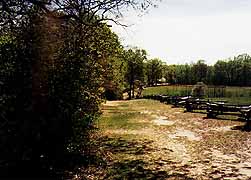
Shiloh Battlefield
|
Shiloh stands out from other huge battles for many reasons. It
was not a fight for a crucial place or a strategic resource or
a population center. Two armies were moving into position to fight
and one surprised the other. The fighting was done in woods and
open fields. In two days more men were killed than in any battle
in human history (until Antietam later in 1862 and Gettysburg
in 1863 topped the grisly number). The Confederates massed the
greatest number of cannons in history to date at Shiloh, too.
With all of this, the outcome of the battle was inconclusive.
Shiloh was woods and fields then, it’s woods and fields now, just
west of the Tennessee River, almost to the Tennessee-Mississippi
border. The Union army under Grant was moving upriver (south)
after its great victories at Fort Henry and Fort Donelson in Kentucky.
General Johnston and the Confederate army had fallen back from
Tennessee and taken up new positions to protect the railroad lines
linking Memphis and the other river cities with Chattanooga and
Atlanta. Chattanooga’s significance in the war was as a rail center
where east-west lines met at the southern end of the Appalachians.
Beauregard knew of Grant’s advance up the Tennessee and moved
his army north fast. Grant’s army bivouacked by Shiloh to await
more forces coming under General Buell and, apparently, was taken
by surprise.
The Confederate army attacked from the South at dawn on a Sunday.
A small Union scouting party had just set off and intercepted
the advancing attackers. Most Union soldiers were caught sleeping
or just awakening. In the hard first day of fighting the North
was driven back almost to the river. There was hard fighting at
the sunken road (still visible today) and at the Hornets’ Nest
(socalled for the sound of artillery overhead). The 62 Southern
cannon were massed against the Hornet’s Nest and the attackers
seized a large Union force. Grant successfully held the last line
near the river with the help of fire from Union gunboats.
During the night reinforcements (General Buell’s troops) came
from the North. Its counterattack on day two drove the Confederates
back. Johnston had been killed and General Beauregard ordered
a Confederate retreat.
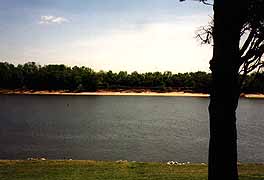
Pittsburg Landing - Shiloh
|
Grant’s and Buell’s forces combined were 65,085 soldiers for the
North. They suffered 13,047 casualties. The South had 43,968 men
at Shiloh and suffered 10,699 casualties. Both sides claimed victory
(!). One fifth of the men participating were injured or killed!
The South claimed it had won the first day’s fighting and done
such damage that the North couldn’t pursue at the end. The North
claimed it had routed the Southern army. |
The Shiloh battlefield is huge, the fight was along a front over
a mile long. The drive takes you through expanses of woods and
fields. There are numerous monuments but they are more spread
out than at Gettysburg (where they crowd the skyline on Cemetery
Ridge). At Shiloh there will be a small white column in a clearing,
a large monument alone in a field. There are some beautiful statues.
At the line where the South massed 62 cannons for the assault
on the Hornets’ Nest, a line of artillery remains (perhaps fifteen).
The drive and signs takes you through the key points in the battle
- from the Hornet’s Nest to the Bloody Pond to the tree where
Johnston died to Grant’s last line near the river at the end of
the first day. At Shiloh the Tennessee is a fairly placid, smooth
running river. The east bank is low and there is a sandy beach
perhaps ten yards wide. The west side is somewhat steeper.
There is an excellent small museum with exhibits on everything
from the equipment of the average soldier at Shiloh to a surgeon’s
tool kit. Some of the artifacts are fascinating (a gunner’s tools,
for example).
In the cemetery, the lines of tombstones follow the contours of
the small hills and hollows in a circle around a central monument
on a bluff overlooking the river. Apparently Beauregard wrote
Grant the day after the battle asking that Southerners be allowed
to claim and bury their dead. Grant replied (courteously) that
he had already buried them (in common trenches).
Some battlefield overwhelm. Shiloh is huge and empty, but there
seem to be men’s shapes flitting through the woods and cries at
the edge of hearing.
We just missed an unsuccessful reenactment of the battle. Thirteen
thousand men turned up to refight the battle, many more than expected,
and were rained out!
A last question. The attack apparently was on a Sunday. Was the
decision to attack at dawn on a SUNDAY difficult to make and controversial?
I have seen no discussion of this. I think of the hate directed
at the Japanese for attacking at Pearl Harbor early on a Sunday.
In 1862 it would have been an even weightier issue, or would it?
4/14.. On to Memphis.
The war is over. We’re owling on to Memphis. And the King. We’re skirting Mississippi’s
northern border, east to west, between the Tennessee River and
the Mississip. The hills are slumping down again, and the long
sweeping strokes of the landscape are getting more lashed by harvesting
machinery. The log rigs are lined up at the entrance to a big
Tenneco mill, turning woods into fiberboard, and raising a stink.
We roll up to a roadwork traffic stop. Just over the brow of the
little rise ahead we can see the top of an old bridge arch. KA-CHRUNCH.
Pieces of rock flying in the air. Now that’s the real ordinance.
And we laugh at the surprise. The worker waves us on. Four guys
are running around on the bypass road, kicking shattered concrete
to either side. One of them is shouting as we bump over the debris:
“He could have waited to let you through.” Rather elegant English
for one pissed dude, I thought.
We moved in and out of sloping woodlands and flat alluvial farmland,
the creeks running yellow with mud. Cypress swamps drowning the
river margins. More beaters and brokedown pickups. Catching sight
of an old main street in our fleeting peripheral vision, we U-turned
to cruise La Grange. Sagging, dingy, and shut up. Tin-roofed shotgun
houses, hip-roofed stores with widesloping eaves and deep porches.
Antique gas pumps under a crooked car port. And one shabby little
brick house, but surrounded by flowers and tacky ornaments. We
waved at the sad-eyed woman rocking with a baby on the porch.
Keep your heart light.
Then the cotton fields turned into horse paddock. We were merging
with the flossy eastern burbs of Memphis. Downtown Collierville,
twenty miles west of La Grange, is a different kettle of poisson.
Quaintly restored. Tea rooms and cachet shoppes. Old railway pullmans
parked beside the station house. Espresso bars. Ladies in mohair
and pearls getting into BMWs. Cops giving longhairs the eyeball.
We caffeine up and out of there.
| But it’s rush hour as we cross into greater Memphis, and we start
looking for a place to hang until the heavy metal goes easy listening.
The Audubon Botanical Gardens in the west end sound like a good
bet, and after a couple of false tries we flutter down into their
lot. The Gardens are a foretaste of the Memphis experience. Half-finished,
a bit seedy, sprawling, full of pretense, but short on charm.
Granted, it’s a relatively new park (although many of the trees
are venerable), but the flowerbeds look slept in. |

Botanical Gardens
|
Our thought was to do some drawings. The “Japanese Mediation Garden”
sounded likely. But it was more in the Japanese dinosaur movie
genre. There was a lacquered red bridge and some stone lanterns,
to be sure, and a couple of crooked pines, but the scale was all
American. Nothing spoke to anything else. And the blessed geese
had shat everywhere. When you approached the turbid waters’ edge
herds of goldfish, some gigantic, congregated at your feet, as
did the geese. You hesitated to get too near the edge. They looked
REAL hungry. The geese honked demandingly.

Meditation Garden
|
Peggy and I wandered off in different directions to draw, and
when we compared our efforts later it was fun to see that we’d
both composed scenes out of dispersed ingredients in the Park.
A mass of azaleas here, a dogwood there, that pine, a stone lantern,
and, of course, the red bridge. May I see you artistic license,
Madam?
|
When we figured it was safe to reinsert the Owl in traffic we
moved in on Memphis. It’s a huge outflung metropolis, going full-throttle
on a maze of sixlanes without mercy. The downtown isn’t visible
from the outer flats, and what is doesn’t entice. It’s a hard-looking
place. We’re back in the Mississippi Valley. The same sinking
feeling we got in Southern Illinois and Southeast Missouri sucks
at you in Memphis. Was it King Cotton and the slave economy, or
just the downhill slide that finally settles out as Mississippi
mud? You feel the ooze of this alluvial angst could swallow all
your joy. And it looks to have done that for the residents.
Those who aren’t hustling you. Every time we made a wrong turn
and pulled in for directions or to use a phone we got spare-changed
and moved in on. Edge City, fellow travelers. We’d been warned
to keep our money in our shoe in this town, and I’d scoffed. Now
I was swallowing my pollyanna. Man, these bottoms are the pits.
Our Super-8 catalog and our Triple-A guides were useless again.
The Motel wasn’t finished yet, and the 4-star restaurant had disappeared,
along with the neighborhood. We settled for a Days Inn in the
flightpath for Memphis International, conveniently adjacent to
a showgirls lounge. And I mean show. |

Bottom Feeders
|
After getting lost again trying to find a recommended dinner,
we seized on a Black Italian Restaurant, playing loud opera to
an unsuspecting audience. In honor of the King we ate way too
much pasta, and bloated back to the Indian subcontinent. That’s
right. Ever since Atlanta the chain motels have once again been
managed by graduates of the New Delhi School of Hostelry. Pronounce
that as you will. The towel racks fall off? The toilet runs? Shrug.








